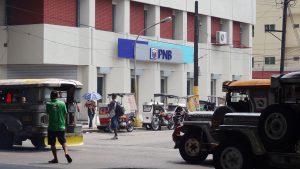PNB eyes offshore bond offer before yearend
PHILIPPINE NATIONAL Bank (PNB) is planning to return to the offshore bond market before yearend to help refinance previously-issued debt maturing this month, its top official said. “We will be floating bonds, perhaps in the later part. We’re targeting December or November,” PNB President and Chief Executive Officer Florido P. Casuela told reporters on the […]

PHILIPPINE NATIONAL Bank (PNB) is planning to return to the offshore bond market before yearend to help refinance previously-issued debt maturing this month, its top official said.
“We will be floating bonds, perhaps in the later part. We’re targeting December or November,” PNB President and Chief Executive Officer Florido P. Casuela told reporters on the sidelines of the PNB-Philippine Airlines (PAL) Mabuhay Miles World Elite Mastercard launch on Wednesday.
Mr. Casuela said the issuance size has yet to be decided, while the tenor of the bond issue could range from three to five years and could be in a sustainability bond format, but noted that nothing has been finalized.
“But right now, we are preparing for that because as I’ve said, we have maturing bonds this month,” he added.
PNB in May said it is looking to raise at least $300 million from an issuance of offshore bonds with an option to upsize.
It also doubled its euro medium-term note program to $2 billion from $1 billion previously. The approved $300-million bond offer will be issued out of this updated program, the bank said.
PNB last tapped the offshore debt market in 2019, raising a record $750 million via fixed-rate senior notes, more than double the $300-million target, as the order book reached $3.25 billion.
These bonds were priced at 99.473% for a yield of 3.391% and a coupon rate of 3.28%.
Proceeds from the offer were used to support PNB’s loan expansion.
CONSUMER LOANS
Meanwhile, PNB is looking to increase its lending to consumers and small businesses, Mr. Casuela said.
“Our mission is to diversify our loan portfolio to the point that we are increasing our exposure to small and medium enterprises and also consumer loans,” he said. “Right now, we have the lowest exposure to consumer loans among banks. So, we are increasing that as a percentage of the total loan portfolio. When you increase this, the percentage of corporate loans will be reduced.”
At present, about 60-70% of the bank’s loan portfolio is made up of corporate loans, he said.
As part of its bid to boost consumer lending, PNB on Wednesday launched the PNB-PAL Mabuhay Miles World Elite Mastercard, which offers low point-to-mile conversion and travel perks such as birthday reward points, online discounts on international flights, and VIP access to airport lounges worldwide, private jets, cruises, and exclusive hotel packages.
Mr. Casuela added that PNB expects a “substantial” increase in lending by next year even as it has seen slower-than-expected loan growth in 2024.
“One thing is that our total loan portfolio has not gone as fast as we would like it to… But by next year, we expect a substantial increase in the portfolio,” he said.
PNB’s loans grew by 2.45% to P631.85 billion in the at end-June from P616.71 billion at end-2023.
However, amid rising credit, banks could see more nonperforming loans (NPL) amid an industry-wide decline in asset quality, Mr. Casuela noted.
Preliminary data from the Bangko Sentral ng Pilipinas (BSP) showed the banking industry’s gross NPL ratio went up to a two-year high of 3.58% in July from 3.51% in June and 3.43% a year ago. This was the highest bad loan ratio in 25 months or since 3.6% in June 2022.
Still, Mr. Casuela said the Philippine banking sector’s outlook remains robust, especially with interest rates going down.
“We are very optimistic for the industry and for PNB. In fact, we are very confident for our performance for next year,” he said. “The reduction of interest rates is a big factor in terms of us giving more loans. It makes it more affordable for those availing of consumer loans — credit card, housing loans, and auto loans, in particular.”
The BSP’s policy-setting Monetary Board on Aug. 15 reduced its policy rate by 25 basis points (bps) to 6.25%, marking its first easing move in nearly four years.
BSP Governor Eli M. Remolona, Jr. has said they could cut rates by another 25 bps within the year. The Monetary Board’s last two policy-setting meetings this year are on Oct. 17 and Dec. 19.
For his part, Mr. Casuela said they expect a total of 50-75 bps in rate reductions from the Philippine central bank for this year.
Lower reserve requirements for banks will also make more funds available for lending, he added.
Mr. Remolona on Wednesday said the BSP plans to reduce big banks’ reserve requirement ratio (RRR) “substantially” this year, with further reductions likely in 2025.
The RRR is the portion of reserves that banks must hold onto rather than lending out. The BSP reduced the ratio for universal and commercial banks and nonbank financial institutions with quasi-banking functions by 250 bps to 9.5% in June 2023.
Mr. Remolona earlier said that they are eyeing to bring down big banks’ RRR to as low as 5% coming from a high of 20% in 2018.
PNB’s attributable net income inched down by 0.07% to P4.95 billion in the second quarter as it set aside higher loan loss provisions. This brought its net income for the first semester to P10.22 billion, up by 4.72% year on year.
Its shares rose by 20 centavos or 0.84% to end at P23.95 apiece on Thursday. — A.M.C. Sy














